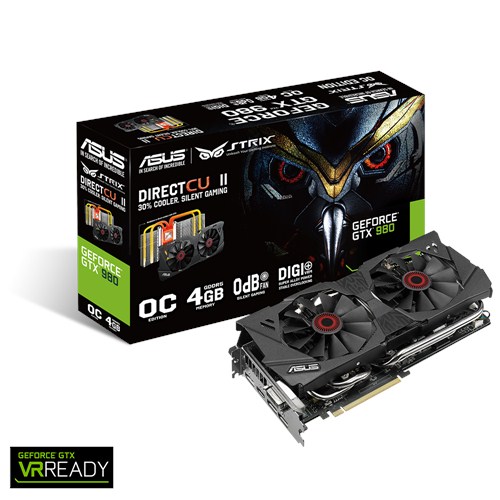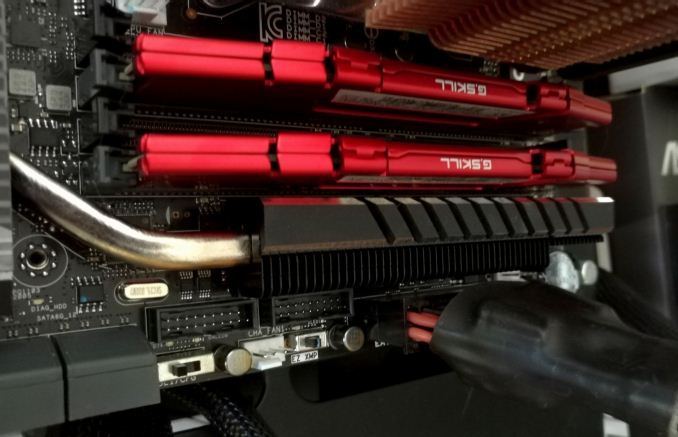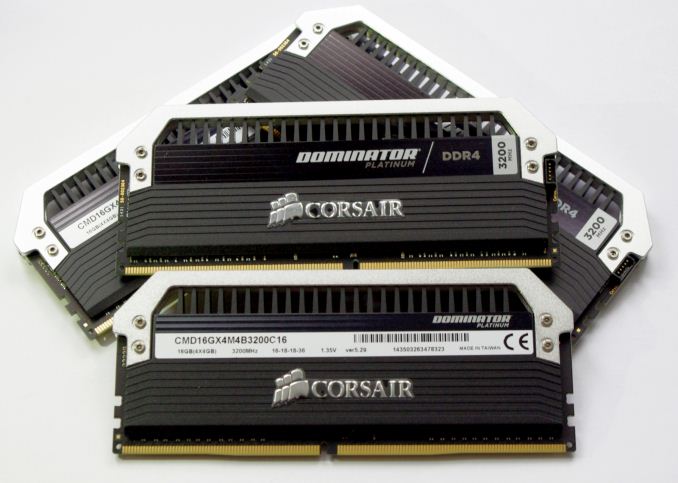The ASUS X99-E-10G WS Motherboard Review: 10GBase-T Networking with Intel’s X550-AT2
by Ian Cutress on November 7, 2016 9:00 AM EST- Posted in
- Motherboards
- Intel
- Asus
- 10G Ethernet
- X99
- 10GBase-T
- X99-E-10G WS
- X550
- X550-AT2
Test Bed and Setup
As per our testing policy, we take a high-end CPU suitable for the motherboard that was released during the socket’s initial launch, and we equip the system with a suitable amount of memory running at the processor maximum supported frequency. This is also typically run at JEDEC subtimings where possible. It is noted that some users are not keen on this policy, stating that sometimes the maximum supported frequency is quite low, or faster memory is available at a similar price, or that the JEDEC speeds can be prohibitive for performance. While these comments make sense, ultimately very few users apply memory profiles (either XMP or other) as they require interaction with the BIOS, and most users will fall back on JEDEC supported speeds - this includes home users as well as industry who might want to shave off a cent or two from the cost or stay within the margins set by the manufacturer. Where possible, we will extend out testing to include faster memory modules either at the same time as the review or a later date.
| Test Setup | |
| Processor | Intel Core i7-5960X ES 8 Cores, 16 Threads, 3.0 GHz (3.5 GHz Turbo) |
| Motherboards | ASUS X99-E-10G WS |
| Cooling | Cooler Master Nepton 140XL |
| Power Supply | OCZ 1250W Gold ZX Series Corsair AX1200i Platinum PSU |
| Memory | Corsair DDR4-2133 C15 4x8 GB 1.2V or G.Skill Ripjaws 4 DDR4-2133 C15 4x8 GB 1.2V |
| Memory Settings | JEDEC @ 2133 |
| Video Cards | ASUS GTX 980 Strix 4GB MSI GTX 770 Lightning 2GB (1150/1202 Boost) ASUS R7 240 2GB |
| Hard Drive | Crucial MX200 1TB |
| Optical Drive | LG GH22NS50 |
| Case | Open Test Bed |
| Operating System | Windows 7 64-bit SP1 |
Readers of our motherboard review section will have noted the trend in modern motherboards to implement a form of MultiCore Enhancement / Acceleration / Turbo (read our report here) on their motherboards. This does several things, including better benchmark results at stock settings (not entirely needed if overclocking is an end-user goal) at the expense of heat and temperature. It also gives an essence of an automatic overclock which may be against what the user wants. Our testing methodology is ‘out-of-the-box’, with the latest public BIOS installed and XMP enabled, and thus subject to the whims of this feature. It is ultimately up to the motherboard manufacturer to take this risk – and manufacturers taking risks in the setup is something they do on every product (think C-state settings, USB priority, DPC Latency / monitoring priority, overriding memory sub-timings at JEDEC). Processor speed change is part of that risk, and ultimately if no overclocking is planned, some motherboards will affect how fast that shiny new processor goes and can be an important factor in the system build.
For reference, the ASUS X99-E-10G WS, on our testing BIOS 0402, MCT was enabled by default. In the event that users buy a board and the BIOS is still a development version (under 0402), we suggest that users update to at least 0402, as before this we experienced sub-optimal performance on development versions before 0402.
Many thanks to...
We must thank the following companies for kindly providing hardware for our multiple test beds. Some of this hardware is not in this test bed specifically, but is used in other testing.
Thank you to AMD for providing us with the R9 290X 4GB GPUs. These are MSI branded 'Gaming' models, featuring MSI's Twin Frozr IV dual-fan cooler design and military class components. Bundled with the cards is MSI Afterburner for additional overclocking, as well as MSI's Gaming App for easy frequency tuning.
The R9 290X is a second generation GCN card from AMD, under the Hawaii XT codename, and uses their largest Sea Islands GPU die at 6.2 billion transistors at 438mm2 built at TSMC using a 28nm process. For the R9 290X, that means 2816 streaming processors with 64 ROPs using a 512-bit memory bus to GDDR5 (4GB in this case). The official power rating for the R9 290X is 250W.
The MSI R9 290X Gaming 4G runs the core at 1000 MHz to 1040 MHz depending on what mode it is in (Silent, Gaming or OC), and the memory at 5 GHz. Displays supported include one DisplayPort, one HDMI 1.4a, and two dual-link DVI-D connectors.
Further Reading: AnandTech's AMD R9 290X Review
Thank you to ASUS for providing us with GTX 980 Strix GPUs. At the time of release, the STRIX brand from ASUS was aimed at silent running, or to use the marketing term: '0dB Silent Gaming'. This enables the card to disable the fans when the GPU is dealing with low loads well within temperature specifications. These cards equip the GTX 980 silicon with ASUS' Direct CU II cooler and 10-phase digital VRMs, aimed at high-efficiency conversion. Along with the card, ASUS bundles GPU Tweak software for overclocking and streaming assistance.
The GTX 980 uses NVIDIA's GM204 silicon die, built upon their Maxwell architecture. This die is 5.2 billion transistors for a die size of 298 mm2, built on TMSC's 28nm process. A GTX 980 uses the full GM204 core, with 2048 CUDA Cores and 64 ROPs with a 256-bit memory bus to GDDR5. The official power rating for the GTX 980 is 165W.
The ASUS GTX 980 Strix 4GB (or the full name of STRIX-GTX980-DC2OC-4GD5) runs a reasonable overclock over a reference GTX 980 card, with frequencies in the range of 1178-1279 MHz. The memory runs at stock, in this case 7010 MHz. Video outputs include three DisplayPort connectors, one HDMI 2.0 connector and a DVI-I.
Further Reading: AnandTech's NVIDIA GTX 980 Review
Thank you to Cooler Master for providing us with Nepton 140XL CLCs. The Nepton 140XL is Cooler Master's largest 'single' space radiator liquid cooler, and combines with dual 140mm 'JetFlo' fans designed for high performance, from 0.7-3.5mm H2O static pressure. The pump is also designed to be faster, more efficient, and uses thicker pipes to assist cooling with a rated pump noise below 25 dBA. The Nepton 140XL comes with mounting support for all major sockets, as far back as FM1, AM2 and 775.
Further Reading: AnandTech's Cooler Master Nepton 140XL Review
Thank you to Corsair for providing us with an AX1200i PSU. The AX1200i was the first power supply to offer digital control and management via Corsair's Link system, but under the hood it commands a 1200W rating at 50C with 80 PLUS Platinum certification. This allows for a minimum 89-92% efficiency at 115V and 90-94% at 230V. The AX1200i is completely modular, running the larger 200mm design, with a dual ball bearing 140mm fan to assist high-performance use. The AX1200i is designed to be a workhorse, with up to 8 PCIe connectors for suitable four-way GPU setups. The AX1200i also comes with a Zero RPM mode for the fan, which due to the design allows the fan to be switched off when the power supply is under 30% load.
Further Reading: AnandTech's Corsair AX1500i Power Supply Review
Thank you to Crucial for providing us with MX200 SSDs. Crucial stepped up to the plate as our benchmark list grows larger with newer benchmarks and titles, and the 1TB MX200 units are strong performers. Based on Marvell's 88SS9189 controller and using Micron's 16nm 128Gbit MLC flash, these are 7mm high, 2.5-inch drives rated for 100K random read IOPs and 555/500 MB/s sequential read and write speeds. The 1TB models we are using here support TCG Opal 2.0 and IEEE-1667 (eDrive) encryption and have a 320TB rated endurance with a three-year warranty.
Further Reading: AnandTech's Crucial MX200 (250 GB, 500 GB & 1TB) Review
Thank you to G.Skill for providing us with memory. G.Skill has been a long-time supporter of AnandTech over the years, for testing beyond our CPU and motherboard memory reviews. We've reported on their high capacity and high-frequency kits, and every year at Computex G.Skill holds a world overclocking tournament with liquid nitrogen right on the show floor. One of the most recent deliveries from G.Skill was their 4x16 GB DDR4-3200 C14 Kit, which we are planning for an upcoming review.
Further Reading: AnandTech's Memory Scaling on Haswell Review, with G.Skill DDR3-3000
Thank you to Corsair for providing us with memory. Similarly, Corsair (along with PSUs) is also a long-time supporter of AnandTech. Being one of the first vendors with 16GB modules for DDR4 was a big deal, and now Corsair is re-implementing LEDs back on its memory after a long hiatus along with supporting specific projects such as ASUS ROG versions of the Dominator Platinum range. We're currently looking at our review pipeline to see when our next DRAM round-up will be, and Corsair is poised to participate.
Further Reading: AnandTech's Memory Scaling on Haswell-E Review

















63 Comments
View All Comments
kgardas - Tuesday, November 8, 2016 - link
Looks really nice, ~6W for 10Gbit is good and very low on todays standard. The only drawback in comparison with Intel is PCIe 2.0 support only, so for 10Gbit you need 4 PCIe lanes. Otherwise I'm looking forward to see this card here...Notmyusualid - Friday, December 2, 2016 - link
@ kgardas: You should have seen our 10G DWDM telecom equipment, back in late 1998... more than 6W I can tell you :) , in fact we couldn't get it to work without forced air, each transceiver taking up a whole rack shelf, and we could only fit three shelves / rack space. The electrical complexity / number of boards to make it work was astounding.Incredible to see it done on a single card now, and more often now, even multiples of, on a single card.
So yes, tech moves on...
Lolimaster - Tuesday, November 8, 2016 - link
I think you should dive the PSU's used.Only a high wattage for multigpu test (850w+)
500-650w Titanium for any cpu + single gpu / APU-intel IGP powered systems
ads295 - Wednesday, November 9, 2016 - link
You know how those clickbait websites show cleavage or a$$?The thumbnail for this article led me to open it in the same vein. :O
Breit - Thursday, November 10, 2016 - link
Thanks for this review Ian, very informative.While reading the comments here, the single feature that seems to attract the most attention is the inclusion of 10G Ethernet. As it seems rather hard to implement a good performing 10G network compared to 1G, maybe an AnandTech-style in-depth article about 10G networking in general would be appreciated by the readers of this site. Just a suggestion.
At least I would appreciate it... ;)
JlHADJOE - Friday, November 11, 2016 - link
Didn't think I'd see the day when an ASUS motherboard is both cheaper and has more features than it's ASRock counterpart.Notmyusualid - Friday, December 2, 2016 - link
More features?I don't see a SATA DOM port.
It is missing 2x 1GB Ethernet ports.
It is missing 2 SATA ports (12 vs 10)
It has only 10-phase power solution, vs 12 phase.
It has no USB 2.0 ports did I read correctly?
It has no fan on the 10G heatsink also, which allows the case temp to equalize with outside temps for some time after shutdown, to avoid condonsation building up in the case.
Can you mount the same range of M.2 SSDs in this? I see only two mounting holes, mine has four...
Board-mounted USB port, for DRM-related stick, or whatever you need connecting / secured on the INSIDE of a case.
I also believe I have LAN LED headers to put network activity on the front panel, as one does with their hard disks.
So tell me if I'm wrong, please.
One thing I'll say, I do find the 6-pin board power connector much more elegant than my 4-pin Molex connector. And I cannot STAND my anodized blue... the black on the ASUS is also more elegant.
Anybody who needs their pcie slots lit, to choose the right combo shouldn't be allowed to buy it..
Notmyusualid - Friday, December 2, 2016 - link
also @ JihadjoeMine has TB header too. Almost forgot about that...
Hixbot - Tuesday, November 22, 2016 - link
Don't understand the move to 10G copper. We should be transitioning towards 10G fiber. Copper can't carry 10G a practical distance. 55 meters for unshielded Cat 6 cable. That't not very far. 100 meters for shielded Cat 6, thats more reasonable. but has anyone priced Cat 6 shielded cable? It's very expensive, and good luck terminating the shielded RJ45 yourself to Cat 6 standards. In my workplace, we've had to order pre-terminated lengths of shielded Cat 6. Whenever we use fiber it's easier to terminate, costs are much cheaper, and distance is practically unlimited.So what is with the move to 10G copper?
Notmyusualid - Friday, December 2, 2016 - link
As an owner of the asrock, I too would have preferred SFP sockets.But SMBs CAN afford $700 for a switch, and many of them have little fiber. My 2c.